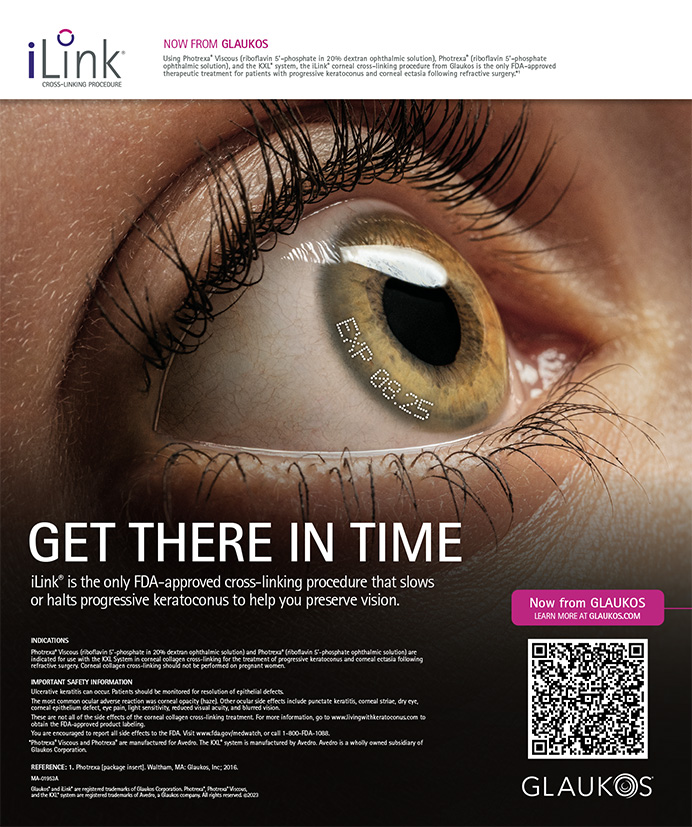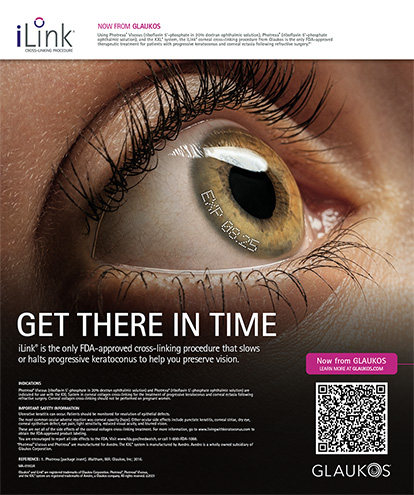When I first experienced dry eye disease (DED) during menopause, I could not find an eye doctor who would pay attention to my complaint or a treatment better than common eye drops. I knew that, as the baby boomer generation aged, the demand for a solution would grow. This led to my researching, developing, and patenting the first oral supplement for DED.
The road to educating eye care providers and the public regarding the value of vitamins and nutrients for ocular function has been long and uphill. However, most big changes come about due to economic pressure, and there are multiple financial angles to this story. First, with the aging population, Wall Street is enthusiastically supporting companies that provide solutions for the discomforts of aging. Second, the rising cost of health care is motivating consumers to embrace nutrition, make lifestyle changes, and search for ways to age more gracefully.
While the Age-Related Eye Disease Study (AREDS) is perhaps the best known study of ocular nutrition, there is a vast amount of high-quality research that provides excellent direction on how we can protect our eyesight, which most people list as their most valued sensory asset.
WHAT WE KNOW
Not long ago, the only thing we knew about lutein and zeaxanthin was that they are the primary carotenoids in the macula, and few eye care professionals assigned them much importance. Research has since taught us that lutein makes up the outer edge of the macula, with meso-zeaxanthin next and zeaxanthin in the center of the macula. These three xanthophylls compose the macular pigment.1 A healthy macular pigment absorbs blue light, protects the underlying photoreceptor cells, and is inversely associated with the incidence of age-related macular degeneration (AMD).
The Veterans Lutein Antioxidant Supplementation Trial (LAST) was a double-masked, placebo-controlled, randomized trial assessing lutein and antioxidant supplementation as an intervention for atrophic AMD.2 In that study, 90 patients with atrophic AMD received either 10 mg of lutein; 10 mg of a broad-spectrum supplementation of vitamins, minerals, and antioxidants; or a maltodextrin placebo.
Both groups receiving lutein experienced improvements in mean macular pigment optical density and Snellen-equivalent visual acuity. The lutein-only group also had a net subjective improvement on Amsler grid testing. Patients who received placebo had no significant changes in any of the measured findings.
An inverse relationship between lutein and zeaxanthin and risk for AMD has been reported in multiple studies. The Blue Mountains Eye Study, a population-based cohort study (N = 3,654), found that a higher dietary intake of lutein and zeaxanthin reduced the risk of AMD by 65%.3 Other major epidemiologic studies have confirmed that higher dietary and serum levels of lutein and zeaxanthin are associated with significantly lower odds ratios of AMD.4,5
The LAST study and others have shown that dietary supplementation of lutein and the zeaxanthins also improves visual function, including increased contrast sensitivity, reduced glare, improved photostress recovery time, and improved high-contrast near visual acuity.2,6,7
Richer was one of the first to look at the effects of a much larger multiple-vitamin product on the eye, and data from other investigators have shown that vitamins A, C, and E; iron; and zinc all have positive benefits to ocular health including improving photoreceptor function and providing protective antioxidant activity.2,8-10
Oxidative stress is believed to contribute to the pathogenesis of many diseases, and mitochondrial DNA has been shown to be particularly prone to oxidative damage.11 With this in mind, Feher and colleagues examined the important role that mitochondrial health plays in AMD and other diseases of the eye.12 In a pilot study, 14 patients affected by early AMD were treated with a mixture of mitotropic compounds including acetyl-L-carnitine, polyunsaturated fatty acids, coenzyme Q10, and vitamin E. Compared with an equal number of age- and sex-matched patients who received only vitamin E, the patients receiving the mitotropic compounds showed improvement in recovery time after macular photostress, foveal sensitivity, mean defect in visual field, and blood lipid levels.
This study was followed by a randomized, double-masked, placebo-controlled trial including more than 100 patients given the same mitotropic compounds.12 The primary efficacy variable was the change in mean visual field defect, and secondary measures included Snellen visual acuity, foveal sensitivity, and fundus alterations. The mean changes in all four of these parameters showed significantly more improvement in the treated group than in the placebo group, strongly suggesting that an appropriate combination of compounds that affect mitochondrial lipid metabolism may improve and subsequently stabilize visual function and fundus alterations.
THE SUM OF THE PARTS
Although studies tend to evaluate the impact of individual nutrients, we must not forget that these compounds work together synergistically. The effect can be compared to a symphony: each instrument is balanced with the whole group, and if even one player is missing, the result is not the same. It is easy to get out of biochemical balance. A multivitamin that combines a large variety of nutrients is better than combining a number of individual supplements that may overlap in some nutrients but omit others. It is essential to consider whole body health. Mitochondrial antioxidants have been linked to improved aging of the brain.13 Lutein has been found in breast milk and is associated with optimal auditory function, among other benefits. It is not possible to separate the body into distinct systems.
The eye is reflective of the rest of the body, particularly where nutrition is concerned. My company Biosyntrx is focused on embracing whole body health in multiple ways. We have always looked at ways to help our clients avoid a deficiency in any major nutrients. Our website (biosyntrx.com) has a comprehensive education center to aid anyone who is interested in expanding his or her knowledge base. Along with an extensive list of peer-reviewed research elucidating the impact of different vitamins and minerals, we offer other blogs that share information about the science of nutrition, nutrient-dense foods, and the appreciation and exploration of art, music, and humanities. We are also heavily involved in continuing education activities for the public as well as eye care professionals.
Consistent with the knowledge of the synergistic characteristics of nutrition, we have also developed a supplement that addresses whole body health. Eye & Body Complete (Biosyntrx) is a dietary supplement of vitamins, minerals, and antioxidant phytochemicals designed to support optimal body and retinal function. The supplement includes 46 different nutrients and does not exceed the Institute of Medicine’s safe upper limits for long-term daily consumption of any ingredient.14
PATIENT EDUCATION
Education requires time, something already in short supply for most clinicians. However, three fairly simple steps can be taken to increase patients’ awareness about ocular nutrition. The first step is to have educational materials available in every ophthalmology and optometry office. The Ocular Nutrition Society (www.ocularnutritionsociety.org) has created an outstanding brochure that does not name any specific products and is available for the cost of the printing. A second step is to include links to websites focused on ocular nutrition on your practice’s website. In addition to the blogs and education sections on the Biosyntrx website, other great options include ZeaVision (www.zeavision.com), ScienceBased Health (www.sciencebasedhealth.com), and Pure Encapsulations (www.pureencapsulations.com).
The final step is to take a small amount of time to ask your patients a few questions about their dietary intake and to briefly discuss weight. This is not a comfortable conversation to have, so we often avoid it. Some larger practices bring in nurses or nutritionists to discuss with their patients how diet affects vision. Even briefly addressing these issues can encourage patients to pay more attention to them. If we want to change the tide of rising health care costs, we have to address the biggest culprits.
WALKING THE WALK
With all the recent discussion about health care costs, now is an optimal time to start taking ocular nutrition seriously. Preventing disease through healthy living, rather than treating disease via surgery or pharmaceuticals, is the most plausible way to lower health care costs and improve the quality of life for ourselves and our patients.
When it comes to fitness, we should be role models for the kinds of change we would like to see in this world. For me, that means being as healthy as I can. The lifestyle section of our website showcases our company’s commitment to living healthier each and every day. Biosyntrx strongly believes that appreciation, exploration, and commitment to science, art, music, and the humanities can add significantly to the global greater good and that these are important parts of the intellectual whole. We have tried to create a work environment that encourages our associates to live better mentally and physically. In our small corner of the world, we are endeavoring to alleviate some of the burden on the health care system. n
1. Krinsky NI, Landrum JT, Bone RA. Biologic mechanisms of the protective role of lutein and zeaxanthin in the eye. Annu Rev Nutr. 2003;23:171-201.
2. Richer S, Stiles W, Statkute L, et al. Double-masked, placebo-controlled, randomized trial of lutein and antioxidant supplementation in the intervention of atrophic age-related macular degeneration: the Veterans LAST study (Lutein Antioxidant Supplementation Trial). Optometry. 2004;75(4):216-230.
3. Tan JS, Wang JJ, Flood V, et al. Dietary antioxidants and the long-term incidence of age-related macular degeneration: the Blue Mountains Eye Study. Ophthalmology. 2008;115(2):334-341.
4. Seddon JM, Ajani UA, Sperduto RD, et al. Dietary carotenoids, vitamins A, C, and E, and advanced age-related macular degeneration. Eye Disease Case-Control Study Group. JAMA. 1994;272:1413-1420.
5. Ho L, van Leeuwen R, Witteman J, et al. Reducing the genetic risk of age-related macular degeneration with dietary antioxidants, zinc, and ω-3 fatty acids: The Rotterdam Study. Arch Ophthalmol. 2011;129(6):758-766.
6. Richer SP, Stiles W, Graham-Hoffman K, et al. Randomized, double-blind, placebo-controlled study of zeaxanthin and visual function in patients with atrophic age-related macular degeneration, The Zeaxanthin and Visual Function Study FDA IND #78, 973. Optometry. 2011;82:667-680.
7. Stringham JM, Hammond BR. Macular pigment and visual performance under glare conditions. Optom Vis Sci. 2008;85(2):82-88.
8. Solessio E, Umino Y, Cameron DA, et al. Light responses in rods of vitamin A-deprived Xenopus. Invest Ophthalmol Vis Sci. 2009;50(9):4477-4486.
9. Valero MP, Fletcher AE, De Stavola BL, et al. Vitamin C is associated with reduced risk of cataract in a Mediterranean population. J Nutr. 2002;132(6):1299-1306.
10. Wells SR, Jennings MH, Rome C, et al. Alpha-, gamma- and delta-tocopherols reduce inflammatory angiogenesis in human microvascular endothelial cells. J Nutr Biochem. 2010;21(7):589-597.
11. Liang FQ, Godley BF. Oxidative stress-induced mitochondrial DNA damage in human retinal pigment epithelial cells: a possible mechanism for RPE aging and age-related macular degeneration. Exp Eye Res. 2003;76(4):397-403.
12. Feher J, Kovacs B, Dovacs I, et al. Improvement of visual functions and fundus alterations in early age-related macular degeneration treated with a combination of acetyl-L-carnitine, n-3 fatty acids, and coenzyeme Q10. Ophthalmoloqica. 2005;219(3):154-166.
13. Zimmer JP, Hammond BR Jr. Possible influences of lutein and zeaxanthin on the developing retina. Clin Ophthalmol. 2007; 1(1):25-35.
14. Institute of Medicine of the National Academies. Sustainable Diets: Food for Healthy People and a Healthy Planet: Workshop Summary–2014. The National Academies Press. www.nap.edu. Accessed September 15, 2014.
Ellen Troyer, MT, MA
• CEO and chief research officer of Biosyntrx with more than 30 years’ experience in medical science
• active member of numerous professional associations dedicated to nutrition and medicine
• etroyer@biosyntrx.com


